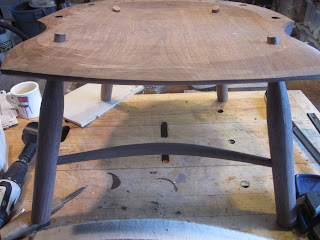Let's face it, there are enough chairs in the out there. I don't rush to the shop concerned that someone is lacking a place to sit. I go for the joy and challenge of making. For the most part, the chairs that I make leave my shop and I am left pondering the next chair, my tools and my process. As I assume it is with most folks, it's about exploring the limits of my tools and my ability.
And as do most folks, I've looked for help. The magazines and books guided and inspired me, but in the end, I was left guessing whether my results were hitting the mark. The funny thing is, even after all these years, the desire to get more from my tools and process has only deepened.
A case in point just pulled up as I was writing this. My friend Scott came over last week and I helped him reshape his turning tools. This time he came over for a couple of chunks of maple to try them out on. He was remarking how excited he was to get back to the lathe now that his tools were better shaped. I know well the frustration he must have felt turning before.
In a broad sense, this is what the class at Kelly's is about. We will investigate the geometry and function of tools we have and ones that we are making to get the most out of our woodworking experience.Whether it's the holding power of our shave horse or the angle of the handles of our drawknives, we'll be addressing our expectations head on.
One project that I am excited about is making adzes.
Tim Manney and I have turned our attention to designing a new adze.
Tim had great experience in Peru watching the folks use adzes and I've always made my own adzes, first for financial reasons and lately because I haven't been impressed by the ones available. And, oh yeah, did I mention financial reasons?
 |
| Grinding the Blade |
 |
| A Rough Prototype |
On the process of chairmaking, we'll start with my basic goal as a chairmaker.
I don't want to make a chair, I want to make any chair. That means that I am not satisfied to have a single design, instead, I want a process that functions to bring to life whatever I can imagine. The Windsor technology is a perfect framework for this, as the limitations that it offers have led me to come up with some simple landmarks and techniques for connecting the dots.
Chairs can be mysterious, even to experienced makers, but I think that with a little focus on design and process, you can understand the variables and their meaning.
 |
| A Chair Near Completion |






































